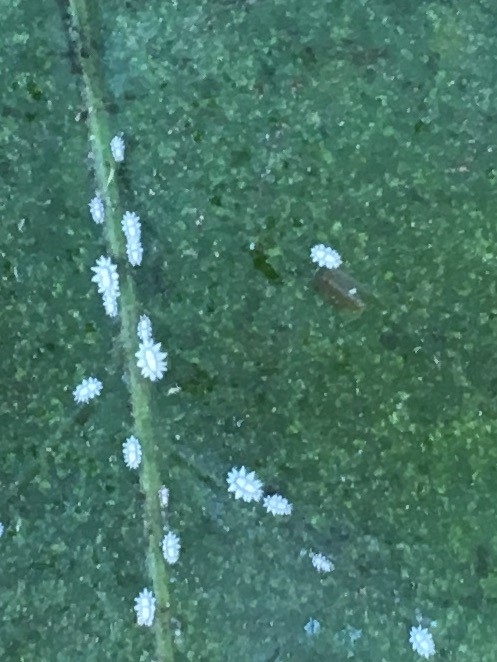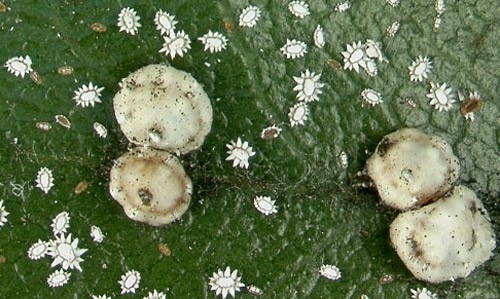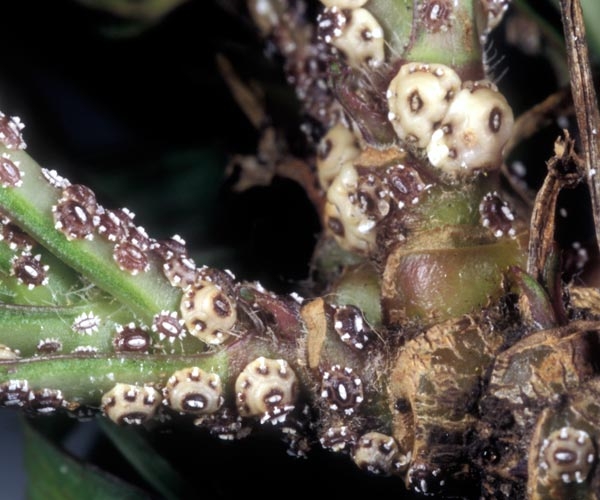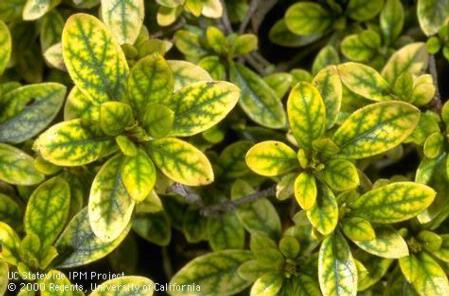
Posts Tagged: lime
Invasive Scale?
Recently a grower called up with a beautiful scale that the PCA couldn't identify. I could just marvel at the beauty of it and wondered what in the heck it was. It didn't look like any scale I had seen in the area and others who were queried didn't know either.
I took it into the Ag Commissioner's office and they sent it off to see if it was a new species. Images were sent off to various entomologists and David Haviland in Bakersfield identified it as a Ceroplastes, possibly a Chinese wax scale or Barnacle scale. Others had identified it as Florida wax scale.
It was sent into Paul Rugman-Jones at UC Riverside Entomology for DNA identification. His identification and that of CA Dept of Food and Ag entolomogists came back as Barnacle scale, Ceroplastes cirripediformis.
All of these scales turned out to have been seen in California before, so there was no quarantine issue. It also turned out that all of the adults that were turned in for identification had also been parasitized by some wasp. So there is biological control already in place for it. The issue at stake here, though, is that it's important to be watching for new visitors in the orchard. Joe Morse now retired from UC Riverside Entomology lead a team that intercepted avocados coming into the US. They found a number of scale insects that were new to California and new to the identification world. A number of these scale are parthenogenic, meaning they can reproduce without males, and just one lone female could possible balloon into a massive population in a short time. And on a scale like that, trees would have a hard time without some serious intervention.
Carbonateceous Soils and Gypsum
Carbonateceous? Gypsum? Read on.
Soil pH or the “acidity” or lack of acidity of a soil can be confused by the different uses and chemistries that surround the term pH, or the power of hydrogen. This can be further confused by the terms “alkalinity” or “basicity” of the soil or the soil solution which can further confuse the situation by whether the solid or liquid phase of the soil is being measured. So, in short, a soil is acid if it has a pH below 7 (more hydrogen ions) and basic when above 7 (fewer hydrogen ions). Big numbers are more basic, small numbers more acidic.
The natural world has a pH scale of 1 to 14. Knowing soil pH is important because it can tell you the inherent fertility of a soil. Usually the higher the number between 5 and 8, the more “basic” nutrients are present, like calcium, magnesium and potassium. When the numbers get lower than 5 and larger than 8, the nutrients may not be there or they may be tied up. Changing the pH can often release nutrients that are not available. Iron and zinc plant deficiencies are most often controlled by soil pH and once pH is neutralized or made acid, the deficiency disappears. In a way, pH is one of the most important nutrient indicators of a soil's fertility and managing should be an essential practice.
Soils that have an elevated pH, those above 7, are usually dominated by carbonate and most commonly this is calcium carbonate. As a rock, we call this limestone which is derived from sea shells or coral. As a mineral, it is called calcite. And in various manipulated forms it is called,calx, lime, calcium hydroxide, calcium oxide,calcined lime, quicklime. Maybe other names, as well, depending on how it is made and used. Mixed with quartz sand it is made into glass. When an acid is added to calcium carbonate, like citric acid, sulfuric acid or rain water (yes pure rain water is acidic), the reaction gives off carbon dioxide and water. (When you respire, burning sugar which is a form of carbonate, you do the same thing, giving off CO2and H2O). When calcium oxide or lime is mixed with water and left to harden, it forms cement when it absorbs carbon dioxide from the air. So, lime, limestone and calcium carbonate are not very soluble. But it does dissolve. Calcium carbonate is a salt and dissociates into calcium ions and when surrounded by water molecules, the carbonate becomes bicarbonate ions. When the water dries up, the bicarbonate becomes carbonate again. A soils report may refer to this cement as “free” or “diffuse lime”, indicating that there is a lot present, and it may even be possible to see the old shells there.
A soil that is dominated by calcium carbonate is called a calcareous soil. It is the carbonate that defines the soil, it has an elevated pH, usually between 7.5 and 8, depending on other minerals in the soil (minerals are naturally occurring chemicals). A high pH leads to plant nutrition problems. It's not until the soil is acidified to drive off the carbonate as carbon dioxide that the pH will drop and the nutrient deficiency disappears.
One of the problems with the word “calcareous” is that it can be interpreted as meaning dominated by calcium. A soil or water analysis may reveal high levels of calcium and this can lead to concern. Calcium is a base cation, necessary for plant and human growth. In western states, water and soil tend to have calcium as the dominant cation, balancing anions like sulfate and carbonate and in some cases chloride. The important character to look for, though, is the carbonate or bicarbonate in the soil or water. It's not the calcium that is controlling pH, it's the carbonate. Very commonly calcium is said “to reduce the acidity of soil.” But it's not the calcium, it's the carbonate.
So, does this seem like a big semantic problem, how many dancing on the head of the pin sort of debate? No, because one of the most common recommendations for correcting an alkaline water/soil is to add gypsum – calcium sulfate. In a calcareous soil, calcium is already present, so adding more calcium is not going to change it, but rather increase it. Sulfate does not displace carbonate. Carbonate just stays there because calcium carbonate is not very soluble. Remember it is cement. Actually, adding gypsum is adding more salt which has its own problems - leading to saline soils.
So, this blog all came about because two different people asked me about correcting iron deficient avocado trees in calcareous soils (or a carbonateceous soil as I call it), with gypsum. pH correction is not going to occur with gypsum. An acid needs to be added to drive the carbonate off as carbon monoxide and then the pH comes down. So, you use acids or elemental sulfur that converts to sulfuric acid or urea-sulfuric acid fertilizer, or long-term use of acid fertilizers like ammonium sulfate or organic mulches that gradually create acid conditions.
Soil acidification as a practice is a separate subject all together that needs to be discussed, but gypsum is not normally a part of the process of field acidification. Does that mean gypsum does not have a place in soil management? It does, just not in the case of calcareous soils. And even though you can see bags of lime and dolomite (calcium-magnesium carbonate) on store shelves, for sure don't use that in the calcareous soils of California.
So, what about gypsum and sodic soils – soils dominated by sodium. And what about serpentine soils – soils dominated by magnesium? There is more to tell about gypsum.
Photo: old shells in the soil

soil shells
Blossom End Rot in Citrus - Another Result of Drought
Another impact of the drought? There have been reports of a sunken, leathery patch around the blossom end (opposite of the stem end) of citrus fruit. This has been reported on lemons, limes and mandarins, but I am sure growers are seeing it on oranges, as well as other citrus relatives. This is an abiotic problem caused by a lack of calcium to the fruit, a problem with the plant's growing conditions, not a disease. This is a serious disorder found in various fruits and vegetables, such as tomatoes, melons, peppers and eggplants
Blossom-end rot begins as small tan, water soaked lesions on the blossom end of the fruit. The lesion enlarges and becomes sunken, dark, and leathery. On peppers, the lesion is more commonly found on the side of the fruit towards the blossom end. Also, on peppers it can be sometimes confused with sun scald. Fruit infected by blossom-end rot ripen often become infected with secondary organisms such as Alternaria spp (most likely the surrounding tissue in the photo below).
This is a physiological disorder of low calcium in the fruit. Calcium is required for normal cell growth and in relatively high concentration for new tissue growth. Rapidly growing fruit will begin to breakdown at the blossom end because that is the last place of the fruit tissue to receive calcium and also the area with the lowest concentration of calcium.
In rapidly growing plants, calcium cannot move to those rapidly growing areas quickly enough. Because calcium moves with water, fluctuations in water supply can cause blossom-end rot. Large fluctuations in soil moisture inhibit uptake and movement of calcium within the plant. Excessive nitrogen promotes rapid plant growth, which can cause low concentrations of calcium to occur in plant tissue. Leaf tissue can often not disclose a low calcium in fruit because of the lag in movement of calcium to the rapidly growing fruit tissue.
Other causes such as low calcium levels in the soil or high amounts of cations in the soil which compete with calcium uptake can also cause blossom-end rot. This is especially true in areas of soils derived from serpentine rock that are high in magnesium. The magnesium competes with calcium uptake.
Proper fertilization and water management help to minimize this problem. Avoid over fertilizing the crop. Also avoid allowing the soil to become too dry and then overly wet. Wide fluctuations in soil moisture inhibit calcium uptake and movement. If calcium is deficient or high salts occur in the soil, gypsum applications can help, but delayed uptake may not help fruit tissue content. Often, foliar applications of calcium may be beneficial.

blossom end rot lemon
Looking for Resistance to Huanglongbing
There is some variability in citrus susceptibility to both the psyllid (Westbrook et al and Hall et al) and the bacterial infection (Shokrollah et al and Stover and Mc Collum). It is not fully clear at this point which of these species would be best to include in a breeding program, but both scions (http://www.concitver.com/3erEIIC2011/Viernes_23_sep/Ed_Stover/Ed_Stover.pdf) and rootstocks (http://www.flcitrusmutual.com/files/4cbb1e3c-1e1f-4b04-a.pdf) are being evaluated.
Some varieties like Australian Finger Lime (Microcitrus australasica) might show more resistance/tolerance to HLB than other species. At the UC Citrus Variety Collection website, it's possible to see the wide range of citrus species that are available for breeding and the commercial availability of those species. The collection is a view into the different materials that breeders can select from, in order to improve resistance to this citrus disease.
Citrus Variety Collection
http://www.citrusvariety.ucr.edu/
Australian Finger Lime Collection and Availability
http://www.citrusvariety.ucr.edu/citrus/microcitrus.html
Susceptibility to Infestation by Asian Citrus Psyllid
Catherine J. Westbrook1, David G. Hall2, Ed Stover, and Yong Ping Duan
http://www.ars.usda.gov/SP2UserFiles/Place/66180000/Westbrook%20et%20al%202011%20HortScience.pdf
D. Hall, C. Westbrook, Y.-P. Duan, E. Stover, R. Lee and M. Richardson http://citrusagents.ifas.ufl.edu/events/fl_citrus2011/Hall%20ACP%20IR%20Citrus%20Expo%202011.pdf
Susceptibility to HLB
Hajivand Shokrollah, Thohirah Lee Abdullah, Kamaruzaman Sijam,Siti Nor Akmar Abdullah and
Nur Ashikin Psyquay Abdullah
http://thescipub.com/PDF/ajabssp.2009.32.38.pdf
Ed Stoverand Greg McCollum
http://hortsci.ashspublications.org/content/46/10/1344.full.pdf+html
Photos
Australian Finger Lime Fruit
Australian Finger Lime Tree

Australian finger lime fruit

Australian finger lime tree
Pruning Cherimoya for Off-season Fruit
A recent trip to Spain was an opportunity to look at their cherimoya production practices. One of the most interesting is their ability to manage the tree through pruning to produce fruit off-season (in spring) when the prices are the highest. IN California our low period of production is in the summer. The climate in Spain along the Mediterranean coast is warmer and more humid than coastal California, so most tree crops are about two months advanced in their production. So in the text I refer to a period when something is done and then follow it with another date. The one in parenthesis is the probable time in California if the date in Spain is used. So, to produce fruit in spring (summer) in March/April when prices are high:
Remove all shoots from the previous year in March (May)
With the new shoots, prune them back 6 inches in length around July 15 (September 15)
Pollinate the flowers that are produced in the period of August to September (Sept/Nov)
Pick fruit in March/April (June/Aug)
Advantages:
Fruit is produced when prices are higher
Generally fewer seeds than at other periods
In some cases there is higher sugar content in the off-season frui
Disadvantages:
Not always consistent with all cultivars
Off-season fruit often has black spots in the pulp
May see increased leaf drop
In some cultivars, the skin is more prone to abrasion, and this is already a very delicate fruit
There are other fruit species that fruiting date can be manipulated by pruning, such as evergreen blueberries, guava, lime, mango and carambola (star fruit). Always it is to find a better market for the fruit.
X
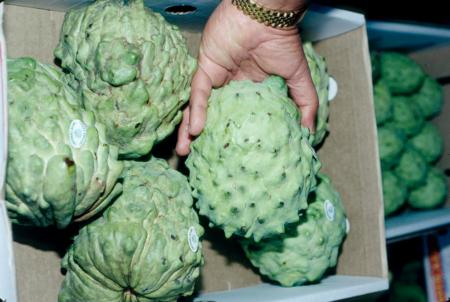
cherimoya

